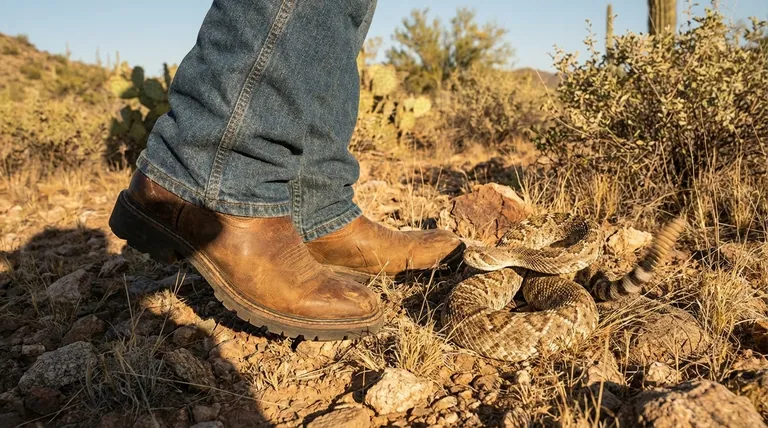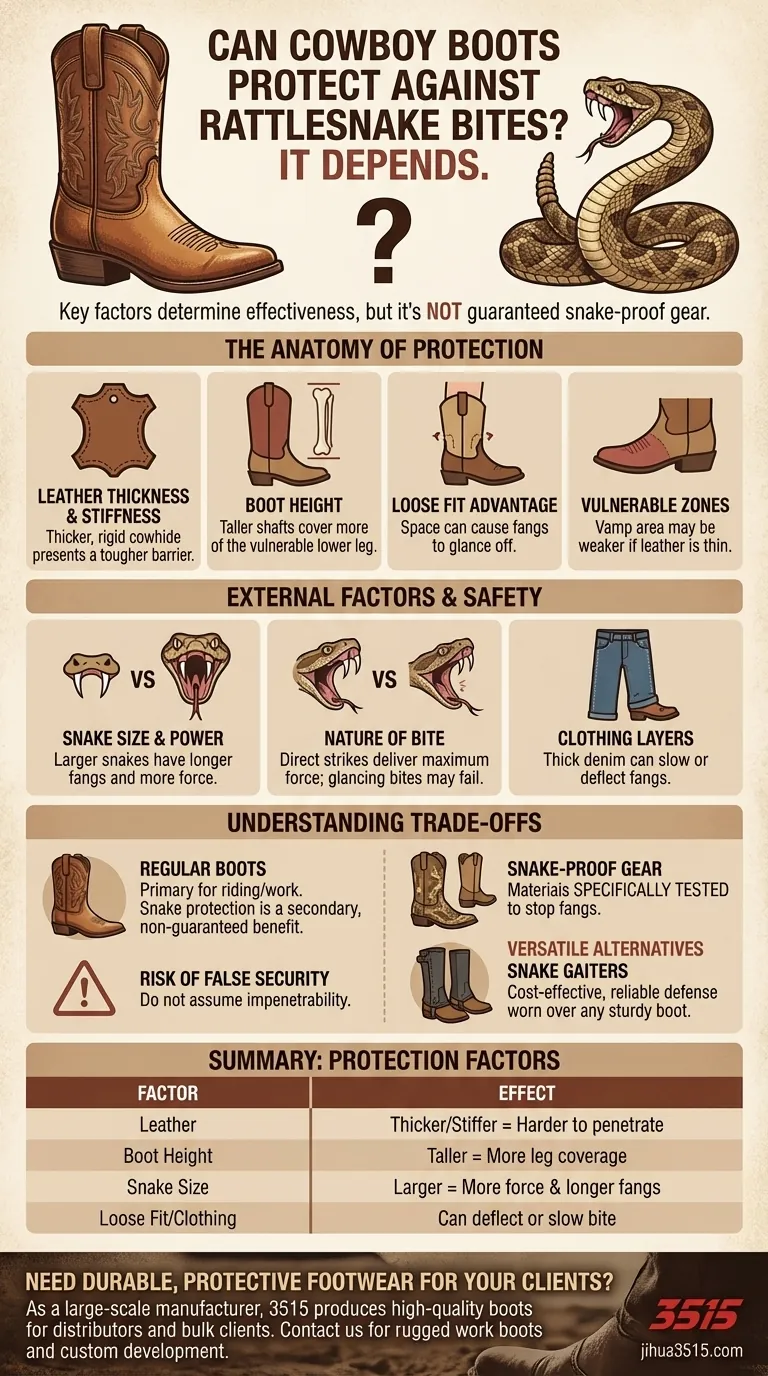The short answer is, it depends. A high-quality, thick leather cowboy boot can offer significant protection against a rattlesnake bite, but it is not a guarantee. Key factors determining its effectiveness include the thickness and stiffness of the leather, the height of the boot shaft, the size of the snake, and the location of the bite.
While a well-made cowboy boot provides a formidable barrier that can often deflect a bite, it should not be confused with certified snake-proof gear. True protection relies on understanding the boot's limitations and the specific risks of your environment.

The Anatomy of Protection: Boot vs. Bite
To understand if a boot will work, you need to analyze the forces at play. A snakebite is a rapid puncture event, and the boot's job is to prevent the fangs from reaching your skin.
The Role of Leather Thickness and Stiffness
The most critical factor is the material itself. Thicker and stiffer leather presents a much tougher barrier for fangs to penetrate. A boot made from thin, pliable leather offers far less protection than one made from rigid, high-quality cowhide.
The Importance of Boot Height
Most rattlesnake bites occur on the lower extremities, between the ankle and the knee. A taller boot shaft physically covers more of this vulnerable area, providing a larger zone of protection.
The 'Loose Fit' Advantage
The space between your leg and the boot's shaft can be a surprising advantage. This gap can cause a snake's fangs to glance off or fail to make a solid, direct impact, preventing a successful envenomation.
Vulnerable Zones to Consider
While the thick sole of a cowboy boot offers excellent protection for the bottom of your foot, the vamp—the area covering the top and sides of your foot—can be a weaker point if the leather is not sufficiently robust.
External Factors That Influence Safety
The boot is only one part of the equation. The snake and the situation itself play an equally important role in the outcome.
The Snake's Size and Power
A small rattlesnake with short fangs has a much lower chance of penetrating a sturdy boot than a large, mature one. A bigger snake can strike with more force and has longer fangs capable of piercing thicker materials.
The Nature of the Bite
Not all bites are equal. A direct, head-on strike delivers maximum force. However, a glancing or indirect bite may not have enough power to get through the leather, even if the fangs make contact.
The Layering Effect of Clothing
Wearing thick denim jeans over your boots adds another layer of defense. This fabric can help slow the fangs or even deflect the strike before it ever reaches the boot's leather.
Understanding the Trade-offs: Protection vs. Peace of Mind
Relying on cowboy boots for snake protection involves accepting a degree of risk. It's crucial to distinguish between a boot that might protect you and one that is designed to protect you.
Regular Boots vs. Snake-Proof Gear
Cowboy boots are built for riding and work; snake protection is a secondary benefit. In contrast, dedicated snake boots or gaiters are made from materials specifically tested and proven to stop snake fangs.
The Risk of a False Sense of Security
The greatest danger is assuming any cowboy boot is impenetrable. This assumption can lead to risky behavior in snake-prone areas. Always treat your boots as a layer of resistance, not an absolute shield.
The Value of Versatile Alternatives
For those who need guaranteed protection without buying new footwear, snake gaiters are an excellent solution. These guards wrap around your lower legs and can be worn over any sturdy boot, offering a cost-effective and reliable defense.
Making the Right Choice for Your Goal
Your decision should be based on a realistic assessment of your environment and activities.
- If your primary focus is casual wear with incidental snake exposure: A well-constructed, thick leather cowboy boot provides a reasonable and significant layer of protection.
- If your primary focus is working or hiking in known rattlesnake habitats: You should invest in certified snake-proof boots or add snake gaiters over your existing boots for reliable safety.
- If your primary focus is maximizing protection on a budget: Snake gaiters are the most cost-effective and versatile option to guarantee your safety.
Ultimately, choosing your gear based on your specific level of risk is the most effective strategy for staying safe.
Summary Table:
| Factor | How It Affects Protection |
|---|---|
| Leather Thickness & Stiffness | Thicker, stiffer leather is harder for fangs to penetrate. |
| Boot Shaft Height | A taller boot protects more of the vulnerable lower leg. |
| Snake Size & Power | Larger snakes have longer fangs and more striking force. |
| Loose Fit & Clothing | A loose fit and thick denim can deflect or slow a bite. |
Need Durable, Protective Footwear for Your Clients?
As a large-scale manufacturer, 3515 produces a comprehensive range of high-quality boots and footwear for distributors, brand owners, and bulk clients. Whether you need rugged work boots with enhanced protective features or are looking to develop a custom line, our production capabilities encompass all types of shoes and boots.
Contact us today to discuss your manufacturing needs and discover how we can bring value and reliability to your product line.
Visual Guide

Related Products
- Custom Wholesale Leather Safety Boots Direct Factory Manufacturing
- Customizable Anti-Smash Safety Boots for Wholesale & Private Label Manufacturing
- Premium Grain Leather Safety Boots for Bulk Supply
- Premium Wholesale Wheat Nubuck Safety Boot with Rapid Lacing System
- Premium Wholesale Waterproof Safety Boots High Performance Protection for Industrial Markets
People Also Ask
- Why is the last important in work boot design? It's the Anatomical Blueprint for Comfort & Safety
- Do moc toe boots have steel toe? Get Durable, Safety-Compliant Footwear
- Is safety toe better than steel toe? A Guide to Choosing the Right Protection
- What are the differences between steel toe, composite toe, and alloy toe Wellington boots? Choose the Right Safety Toe for Your Job
- Is there a downside to steel toe boots? Weighing Protection Against Daily Comfort



















